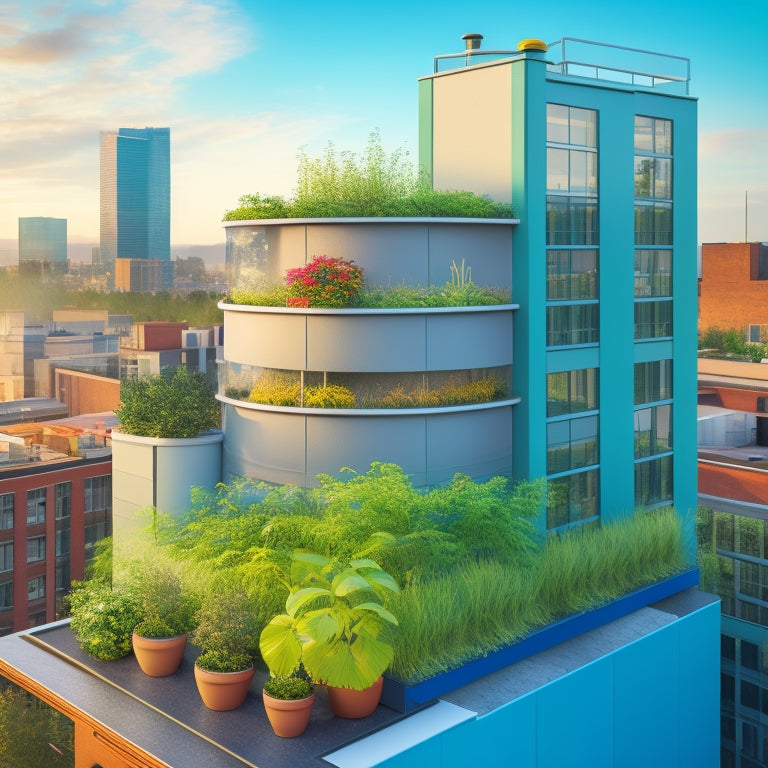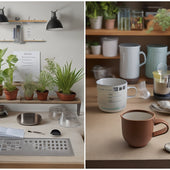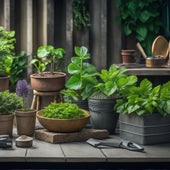
5 Ways to Harvest Rainwater on Apartment Roofs
Share
You're sitting on a valuable resource - your apartment roof - that can be harnessed to collect and conserve precious rainwater. You can design a rooftop garden with built-in water collection systems or install rain barrels and tanks to collect and store rainwater efficiently. Connecting downspouts to gutters redirects rainwater away from your foundation, while using rain chains adds an aesthetic touch. Implementing green roof systems integrates ecological benefits with rainwater harvesting. By exploring these five methods, you'll be on your way to reducing your water bills and contributing to a sustainable future - and there's even more to discover.
Key Takeaways
• Design a rooftop garden with built-in water collection systems for efficient rainwater harvesting.
• Install rain barrels or tanks with built-in filtration systems to collect and store rainwater.
• Connect downspouts to gutters to redirect rainwater away from the foundation and into the collection system.
• Use decorative rain chains to control water flow, reduce erosion risks, and enhance aesthetic appeal.
• Implement green roof systems to integrate additional storage, reduce urban heat island effects, and enhance ecological benefits.
Rooftop Rainwater Collection Methods
How do you plan to harness the rainwater that pours down on your apartment roof, and what methods will you use to collect it?
As you explore rooftop rainwater collection methods, consider the benefits of water conservation and the potential to create a thriving rooftop garden. One effective approach is to design a rooftop garden with built-in water collection systems. This not only reduces stormwater runoff but also provides a sustainable way to irrigate your plants.
You can use a drip irrigation system, which delivers water directly to the roots of the plants, minimizing evaporation and runoff. This method is particularly well-suited for urban sustainability, as it reduces the demand on municipal water supplies.
Additionally, rooftop gardens can help mitigate the urban heat island effect, provide insulation, and create a peaceful oasis in the midst of the city. By harnessing rainwater and using it to nourish your rooftop garden, you'll be taking a significant step towards a more sustainable future.
Installing Rain Barrels and Tanks
By installing rain barrels and tanks, you can efficiently collect and store rainwater from your apartment roof, providing a readily available source of water for your rooftop garden and other non-potable uses. When choosing a rain barrel or tank, consider the size, material, and features that suit your needs. Look for ones with built-in filtration systems to remove debris and contaminants, ensuring cleaner water for your plants. Regular maintenance is vital to keep your system running smoothly. Check your barrels and tanks regularly for leaves, sediment, and overflows, and perform routine cleaning to prevent mosquito breeding.
Cost considerations are crucial when selecting a rainwater harvesting system. While the initial investment may seem high, the long-term water usage benefits will save you money on your water bill. Additionally, using rainwater for non-potable purposes reduces your reliance on municipal water supplies, giving you more freedom and control over your water usage.
Connecting Downspouts to Gutters
One essential step in harvesting rainwater on your apartment roof is to properly link your downspouts to your gutters, guaranteeing that rainwater flows smoothly into your collection system. This connection is vital for effective rainwater diversion and rooftop drainage. By linking your downspouts to your gutters, you can redirect rainwater away from your foundation and into your collection system.
Here are some key considerations for linking your downspouts to your gutters:
| Connection Type | Material | Benefits |
|---|---|---|
| Flexible Downspout Adapter | PVC or Aluminum | Easy to install, flexible link |
| Rigid Downspout Adapter | PVC or Aluminum | Secure link, less prone to damage |
| Gutter Guard Attachment | Stainless Steel or Aluminum | Reduces debris, easy to clean |
| Downspout Redirection Kit | PVC or Aluminum | Redirects rainwater away from foundation |
When linking your downspouts to your gutters, make sure to choose a connection type that suits your needs and roof type. Proper linking will guarantee that rainwater flows smoothly into your collection system, giving you a reliable source of water for your apartment. By doing so, you'll be able to enjoy the freedom of harvesting rainwater and reducing your water bills.
Using Rain Chains for Harvesting
You can add a touch of elegance to your rainwater harvesting system while improving its functionality by incorporating rain chains, which replace traditional downspouts with a decorative and effective alternative. These chains not only enhance the aesthetic appeal of your apartment's exterior but also provide several benefits.
To start with, rain chains allow for a slower and more controlled water flow, reducing the risk of erosion and overflow. Additionally, they create a soothing sound as the water flows down, adding to the ambiance of your outdoor space.
When installing rain chains, make sure to follow a few essential tips. To begin with, choose a chain that's durable and resistant to corrosion, such as copper or stainless steel. In addition, ensure the chain is properly secured to the gutter system to prevent it from getting damaged or dislodged during heavy rain. Finally, consider adding a debris catcher or filter to the top of the chain to prevent leaves and other particles from clogging the system.
Implementing Green Roof Systems
Take your rainwater harvesting system to the next level by integrating a green roof, which not only provides additional storage capacity but also offers a range of ecological benefits. By incorporating plants, soil, and other materials, you'll create a habitat for local wildlife, reduce urban heat island effects, and even mitigate stormwater runoff.
Here are some key benefits of green roof systems:
| Benefits | Description | Impact |
|---|---|---|
| Stormwater Management | Reduces runoff, filters water | Decreased burden on drainage systems |
| Urban Heat Island Mitigation | Evapotranspiration cools the air | Improved air quality, reduced heat stress |
| Biodiversity | Provides habitat for local species | Increased urban ecosystem health |
| Noise Reduction | Soil, plants, and materials absorb sound | Improved acoustic comfort |
| Aesthetic Value | Creates a natural, peaceful atmosphere | Enhanced quality of life |
Frequently Asked Questions
Are There Any Local Regulations Restricting Rainwater Harvesting in My Area?
'Don't assume you're off the hook - you'll likely need permits and must navigate local regulations. Research your area's legal considerations and potential barriers to guarantee you're not caught off guard.'
How Do I Ensure the Water Is Safe for Drinking and Cooking?
You'll want to guarantee harvested water is safe for drinking and cooking by implementing a reliable water filtration system and regularly using testing methods, like lab analysis or DIY kits, to monitor water quality.
Can I Connect My Rainwater Harvesting System to My Plumbing?
You can connect your rainwater harvesting system to your plumbing, but consider the benefits and safety implications first, ensuring a secure connection that meets local codes and protects your water supply.
Will Rainwater Harvesting Increase My Property's Value?
You're like a savvy investor, diversifying your portfolio - and installing a rainwater harvesting system can be a smart move, increasing your property's value through landscaping benefits, cost savings, and a reduced environmental impact.
How Much Maintenance Is Required for a Rainwater Harvesting System?
You'll need to establish a maintenance schedule to guarantee your rainwater harvesting system runs smoothly, but the benefits of system efficiency and cost savings, plus the environmental impact, make it well worth the effort.
Related Posts
-

Accurate Measurements for Self-Watering Planters Made Easy
You're about to reveal the secrets of self-watering planters, and it all starts with precise measurements. Begin by a...
-

Accurate Measurements for Self-Watering Planters Made Easy
You're about to reveal the secrets of self-watering planters, and it all starts with precise measurements. Begin by a...
-

Accurate Measurements for Self-Watering Planters Made Easy
You're about to reveal the secrets of self-watering planters, and it all starts with precise measurements. Begin by a...
-

Accurate Measurements for Self-Watering Planters Made Easy
You're about to reveal the secrets of self-watering planters, and it all starts with precise measurements. Begin by a...
-

Accurate Measurements for Self-Watering Planters Made Easy
You're about to reveal the secrets of self-watering planters, and it all starts with precise measurements. Begin by a...
-

Accurate Measurements for Self-Watering Planters Made Easy
You're about to reveal the secrets of self-watering planters, and it all starts with precise measurements. Begin by a...
-

Accurate Measurements for Self-Watering Planters Made Easy
You're about to reveal the secrets of self-watering planters, and it all starts with precise measurements. Begin by a...
-

Accurate Measurements for Self-Watering Planters Made Easy
You're about to reveal the secrets of self-watering planters, and it all starts with precise measurements. Begin by a...
-

Accurate Measurements for Self-Watering Planters Made Easy
You're about to reveal the secrets of self-watering planters, and it all starts with precise measurements. Begin by a...
-

Accurate Measurements for Self-Watering Planters Made Easy
You're about to reveal the secrets of self-watering planters, and it all starts with precise measurements. Begin by a...
-

Accurate Measurements for Self-Watering Planters Made Easy
You're about to reveal the secrets of self-watering planters, and it all starts with precise measurements. Begin by a...
-

Accurate Measurements for Self-Watering Planters Made Easy
You're about to reveal the secrets of self-watering planters, and it all starts with precise measurements. Begin by a...
-

Accurate Measurements for Self-Watering Planters Made Easy
You're about to reveal the secrets of self-watering planters, and it all starts with precise measurements. Begin by a...
-

Accurate Measurements for Self-Watering Planters Made Easy
You're about to reveal the secrets of self-watering planters, and it all starts with precise measurements. Begin by a...
-

Accurate Measurements for Self-Watering Planters Made Easy
You're about to reveal the secrets of self-watering planters, and it all starts with precise measurements. Begin by a...
-

Accurate Measurements for Self-Watering Planters Made Easy
You're about to reveal the secrets of self-watering planters, and it all starts with precise measurements. Begin by a...
-

Accurate Measurements for Self-Watering Planters Made Easy
You're about to reveal the secrets of self-watering planters, and it all starts with precise measurements. Begin by a...
-

Accurate Measurements for Self-Watering Planters Made Easy
You're about to reveal the secrets of self-watering planters, and it all starts with precise measurements. Begin by a...
-

Accurate Measurements for Self-Watering Planters Made Easy
You're about to reveal the secrets of self-watering planters, and it all starts with precise measurements. Begin by a...
-

Accurate Measurements for Self-Watering Planters Made Easy
You're about to reveal the secrets of self-watering planters, and it all starts with precise measurements. Begin by a...
-

Accurate Measurements for Self-Watering Planters Made Easy
You're about to reveal the secrets of self-watering planters, and it all starts with precise measurements. Begin by a...
-

Accurate Measurements for Self-Watering Planters Made Easy
You're about to reveal the secrets of self-watering planters, and it all starts with precise measurements. Begin by a...
-

Accurate Measurements for Self-Watering Planters Made Easy
You're about to reveal the secrets of self-watering planters, and it all starts with precise measurements. Begin by a...
-

Accurate Measurements for Self-Watering Planters Made Easy
You're about to reveal the secrets of self-watering planters, and it all starts with precise measurements. Begin by a...
-

Accurate Measurements for Self-Watering Planters Made Easy
You're about to reveal the secrets of self-watering planters, and it all starts with precise measurements. Begin by a...
-

Accurate Measurements for Self-Watering Planters Made Easy
You're about to reveal the secrets of self-watering planters, and it all starts with precise measurements. Begin by a...
-

Accurate Measurements for Self-Watering Planters Made Easy
You're about to reveal the secrets of self-watering planters, and it all starts with precise measurements. Begin by a...
-

Accurate Measurements for Self-Watering Planters Made Easy
You're about to reveal the secrets of self-watering planters, and it all starts with precise measurements. Begin by a...
-

Accurate Measurements for Self-Watering Planters Made Easy
You're about to reveal the secrets of self-watering planters, and it all starts with precise measurements. Begin by a...
-

Accurate Measurements for Self-Watering Planters Made Easy
You're about to reveal the secrets of self-watering planters, and it all starts with precise measurements. Begin by a...
-

Accurate Measurements for Self-Watering Planters Made Easy
You're about to reveal the secrets of self-watering planters, and it all starts with precise measurements. Begin by a...
-

Why Do Cinder Block Planter Tools Cost So Much
You'll likely spend at least $200 to $500 on essential tools for a DIY cinder block planter project, with high-end op...
-

Why Do Cinder Block Planter Tools Cost So Much
You'll likely spend at least $200 to $500 on essential tools for a DIY cinder block planter project, with high-end op...
-

Why Do Cinder Block Planter Tools Cost So Much
You'll likely spend at least $200 to $500 on essential tools for a DIY cinder block planter project, with high-end op...
-

Why Do Cinder Block Planter Tools Cost So Much
You'll likely spend at least $200 to $500 on essential tools for a DIY cinder block planter project, with high-end op...
-

Why Do Cinder Block Planter Tools Cost So Much
You'll likely spend at least $200 to $500 on essential tools for a DIY cinder block planter project, with high-end op...
-

Why Do Cinder Block Planter Tools Cost So Much
You'll likely spend at least $200 to $500 on essential tools for a DIY cinder block planter project, with high-end op...
-

Why Do Cinder Block Planter Tools Cost So Much
You'll likely spend at least $200 to $500 on essential tools for a DIY cinder block planter project, with high-end op...
-

Why Do Cinder Block Planter Tools Cost So Much
You'll likely spend at least $200 to $500 on essential tools for a DIY cinder block planter project, with high-end op...
-

Why Do Cinder Block Planter Tools Cost So Much
You'll likely spend at least $200 to $500 on essential tools for a DIY cinder block planter project, with high-end op...
-

Why Do Cinder Block Planter Tools Cost So Much
You'll likely spend at least $200 to $500 on essential tools for a DIY cinder block planter project, with high-end op...
-

Why Do Cinder Block Planter Tools Cost So Much
You'll likely spend at least $200 to $500 on essential tools for a DIY cinder block planter project, with high-end op...
-

Why Do Cinder Block Planter Tools Cost So Much
You'll likely spend at least $200 to $500 on essential tools for a DIY cinder block planter project, with high-end op...
-

Why Do Cinder Block Planter Tools Cost So Much
You'll likely spend at least $200 to $500 on essential tools for a DIY cinder block planter project, with high-end op...
-

Why Do Cinder Block Planter Tools Cost So Much
You'll likely spend at least $200 to $500 on essential tools for a DIY cinder block planter project, with high-end op...
-

Why Do Cinder Block Planter Tools Cost So Much
You'll likely spend at least $200 to $500 on essential tools for a DIY cinder block planter project, with high-end op...
-

Why Do Cinder Block Planter Tools Cost So Much
You'll likely spend at least $200 to $500 on essential tools for a DIY cinder block planter project, with high-end op...
-

Why Do Cinder Block Planter Tools Cost So Much
You'll likely spend at least $200 to $500 on essential tools for a DIY cinder block planter project, with high-end op...
-

Why Do Cinder Block Planter Tools Cost So Much
You'll likely spend at least $200 to $500 on essential tools for a DIY cinder block planter project, with high-end op...
-

Why Do Cinder Block Planter Tools Cost So Much
You'll likely spend at least $200 to $500 on essential tools for a DIY cinder block planter project, with high-end op...
-

Why Do Cinder Block Planter Tools Cost So Much
You'll likely spend at least $200 to $500 on essential tools for a DIY cinder block planter project, with high-end op...
-

Why Do Cinder Block Planter Tools Cost So Much
You'll likely spend at least $200 to $500 on essential tools for a DIY cinder block planter project, with high-end op...
-

Why Do Cinder Block Planter Tools Cost So Much
You'll likely spend at least $200 to $500 on essential tools for a DIY cinder block planter project, with high-end op...
-

Why Do Cinder Block Planter Tools Cost So Much
You'll likely spend at least $200 to $500 on essential tools for a DIY cinder block planter project, with high-end op...
-

Why Do Cinder Block Planter Tools Cost So Much
You'll likely spend at least $200 to $500 on essential tools for a DIY cinder block planter project, with high-end op...
-

Why Do Cinder Block Planter Tools Cost So Much
You'll likely spend at least $200 to $500 on essential tools for a DIY cinder block planter project, with high-end op...
-

Why Do Cinder Block Planter Tools Cost So Much
You'll likely spend at least $200 to $500 on essential tools for a DIY cinder block planter project, with high-end op...
-

Why Do Cinder Block Planter Tools Cost So Much
You'll likely spend at least $200 to $500 on essential tools for a DIY cinder block planter project, with high-end op...
-

Why Do Cinder Block Planter Tools Cost So Much
You'll likely spend at least $200 to $500 on essential tools for a DIY cinder block planter project, with high-end op...
-

Why Do Cinder Block Planter Tools Cost So Much
You'll likely spend at least $200 to $500 on essential tools for a DIY cinder block planter project, with high-end op...
-

Why Do Cinder Block Planter Tools Cost So Much
You'll likely spend at least $200 to $500 on essential tools for a DIY cinder block planter project, with high-end op...
-

Why Do Cinder Block Planter Tools Cost So Much
You'll likely spend at least $200 to $500 on essential tools for a DIY cinder block planter project, with high-end op...
-

5 Tips for Thriving Vertical Vegetable Gardens
To thrive in vertical vegetable gardening, you'll want to choose a planter that meets the unique needs of your veggie...
-

5 Tips for Thriving Vertical Vegetable Gardens
To thrive in vertical vegetable gardening, you'll want to choose a planter that meets the unique needs of your veggie...
-

5 Tips for Thriving Vertical Vegetable Gardens
To thrive in vertical vegetable gardening, you'll want to choose a planter that meets the unique needs of your veggie...
-

5 Tips for Thriving Vertical Vegetable Gardens
To thrive in vertical vegetable gardening, you'll want to choose a planter that meets the unique needs of your veggie...
-

5 Tips for Thriving Vertical Vegetable Gardens
To thrive in vertical vegetable gardening, you'll want to choose a planter that meets the unique needs of your veggie...
-

5 Tips for Thriving Vertical Vegetable Gardens
To thrive in vertical vegetable gardening, you'll want to choose a planter that meets the unique needs of your veggie...
-

5 Tips for Thriving Vertical Vegetable Gardens
To thrive in vertical vegetable gardening, you'll want to choose a planter that meets the unique needs of your veggie...
-

5 Tips for Thriving Vertical Vegetable Gardens
To thrive in vertical vegetable gardening, you'll want to choose a planter that meets the unique needs of your veggie...
-

5 Tips for Thriving Vertical Vegetable Gardens
To thrive in vertical vegetable gardening, you'll want to choose a planter that meets the unique needs of your veggie...
-

5 Tips for Thriving Vertical Vegetable Gardens
To thrive in vertical vegetable gardening, you'll want to choose a planter that meets the unique needs of your veggie...
-

5 Tips for Thriving Vertical Vegetable Gardens
To thrive in vertical vegetable gardening, you'll want to choose a planter that meets the unique needs of your veggie...
-

5 Tips for Thriving Vertical Vegetable Gardens
To thrive in vertical vegetable gardening, you'll want to choose a planter that meets the unique needs of your veggie...
-

5 Tips for Thriving Vertical Vegetable Gardens
To thrive in vertical vegetable gardening, you'll want to choose a planter that meets the unique needs of your veggie...
-

5 Tips for Thriving Vertical Vegetable Gardens
To thrive in vertical vegetable gardening, you'll want to choose a planter that meets the unique needs of your veggie...
-

5 Tips for Thriving Vertical Vegetable Gardens
To thrive in vertical vegetable gardening, you'll want to choose a planter that meets the unique needs of your veggie...
-

5 Tips for Thriving Vertical Vegetable Gardens
To thrive in vertical vegetable gardening, you'll want to choose a planter that meets the unique needs of your veggie...
-

5 Tips for Thriving Vertical Vegetable Gardens
To thrive in vertical vegetable gardening, you'll want to choose a planter that meets the unique needs of your veggie...


